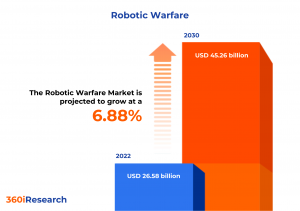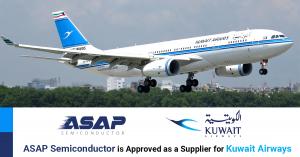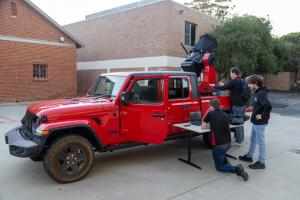
The Global Robotic Warfare Market to grow from USD 26.58 billion in 2022 to USD 45.26 billion by 2030, at a CAGR of 6.88%.
PUNE, MAHARASHTRA, INDIA , December 7, 2023 /EINPresswire.com/ — The “Robotic Warfare Market by Component (Hardware, Software), Capability (Exoskeleton & Wearables, Target Acquisition Systems, Turret & Weapon Systems), Mode of Operation, Application – Global Forecast 2023-2030″ report has been added to 360iResearch.com’s offering.
The Global Robotic Warfare Market to grow from USD 26.58 billion in 2022 to USD 45.26 billion by 2030, at a CAGR of 6.88%.
Request a Free Sample Report @ https://www.360iresearch.com/library/intelligence/robotic-warfare?utm_source=einpresswire&utm_medium=referral&utm_campaign=sample
Robotic warfare includes the integration of unmanned systems, artificial intelligence, and advanced robotics in military operations to augment or replace human soldiers in various tasks. These systems include unmanned aerial vehicles (UAVs), autonomous ground vehicles, underwater drones, and other robotic platforms designed for surveillance, reconnaissance, and combat applications. Growing risks to human soldiers in hazardous environments that prompt increased investment in unmanned systems are expanding the usage of robotic warfare. The precision and accuracy offered by robotic technologies contribute to more effective military operations, and the global geopolitical landscape, marked by rising tensions, fuels the demand for advanced robotic warfare capabilities. Furthermore, the high costs associated with research, development, and implementation of advanced robotic technologies hinder market growth. The development and deployment of autonomous ground vehicles are creating a platform for the growth of the robotic warfare market. The growing integration of artificial intelligence and machine learning algorithms into robotic systems that enhance decision-making capabilities in military operations is expected to create opportunities for market growth.
Component: Growing usage software for ensuring accurate and real-time decisions
In the realm of robotic warfare, the hardware acts as the backbone, providing the physical framework for operations. The platform is the physical robot typically equipped for movement and operation in various terrains, water, air, and sometimes even space. The pulse of robotic warfare, acting as the control center for processing inputs, decision-making, and command outputs, lies in its software components. This is usually a sophisticated layer comprising machine learning algorithms, AI programs for decision-making, image processing software, and real-time data processing systems.
Mode of Operation: High potential of autonomous mode of operation to perform complex actions independently
In the autonomous mode of operation, robotic warfare implements advanced technologies with capabilities to perform complex actions independently, without human supervision. These robotic systems utilize Artificial Intelligence (AI) to intelligently make real-time strategic decisions. Underlying this capability are machine learning algorithms that enable the robots to adapt to changing battlefield conditions and execute tasks such as navigation, target detection, and weapon deployment. The semi-autonomous mode of operation in robotic warfare fuses human intervention with AI decision-making processes. In this mode, robots perform tasks under a supervised learning model, whereby even if the robot makes the initial decision, the final action authorization comes from a human operator, fostering a man-in-the-loop control loop. This cooperative control model minimizes the risks associated with autonomous actions, as humans maintain the overriding power to either approve or halt the machine-decided course of action. In addition, the semi-autonomous operation presents a balance between the need for speedy, efficient decision-making and the essential human control, moral judgment, and accountability in warfare.
Application: Emerging application of robotic warfare in hazardous search & rescue operations
Robotic systems play an essential role in providing situational awareness and making informed decisions. They assist by carrying out stealth surveillance, gathering intelligence on enemy activities, and executing reconnaissance missions spanning over extended geographic areas. These robotic systems can operate in various terrains, ensuring increased surveillance and reconnaissance efficiency with minimized risk to human life. In the military context, logistical robots assist in transporting ammunition, food, medical supplies, and other goods across dangerous terrains. They provide support functions, including equipment maintenance and recovery, reducing the lives risked in these operations. Moreover, robotics aids in automating tedious logistical tasks, thereby augmenting the overall military supply chain efficiency. Robotic systems are indispensable in hazardous search and rescue operations, especially those involving natural disasters or dangerous conflict zones. They allow rescue teams to reach inaccessible areas or situations that are too dangerous for human intervention, providing timely and critical assistance. Robotic warfare technology significantly aids in tracking & targeting adversaries. Advanced systems employ GPS technology, thermal imaging, and artificial intelligence to identify, track, and precisely target enemy assets with minimal collateral damage. Robotic warfare enables the execution of complex battlefield operations more safely and effectively. Robotics is increasingly being used in military training & simulating warzones. They allow soldiers to train under controlled yet realistic combat conditions without risking human lives. It significantly enhances a soldier’s skills and decision-making capabilities in real-world scenarios.
Capability: Rising preference for target acquisition systems to identify and lock onto targets with considerable accuracy
The unmanned platforms & systems form an essential part of the context of robotic warfare and herald a significant shift in the mechanics of the combat zone. These include elements such as unmanned aerial vehicles (UAVs), unmanned ground vehicles (UGVs), and unmanned underwater vehicles (UUVs), each with a specific set of functionalities designed to enhance strategic capabilities while minimizing human exposure to lethal force. Exoskeleton technology & wearables are playing an increasingly crucial role in bolstering the capabilities of ground forces. Exoskeletons augment the physical abilities of the user, allowing for increased strength, speed, and durability. Meanwhile, various wearable technologies, from smart helmets to body sensors, deliver real-time situational awareness and health monitoring to improve decision-making and survivability. Central to robotic warfare is the implementation of sophisticated Target Acquisition Systems (TAS). These are designed to identify and lock onto targets with considerable accuracy, utilizing advanced technologies such as AI-powered image recognition and heat signature detection. This essentially expedites the process of target identification, leading to quicker response times and improved efficiency in combat situations. Turret & weapon systems can independently detect, track, and engage targets by leveraging machine learning and sensor fusion. Coupled with unmanned weapon systems that can accurately launch attacks from long-range, these technologies offer robust defensive and offensive capabilities with reduced risk to human operators.
Regional Insights:
In the Americas, the utilization of robotic warfare technologies is a prominent aspect of military modernization efforts. The region witnesses a significant focus on unmanned systems, including aerial and ground-based robotic platforms. The United States, in particular, plays a leading role in advancing robotic warfare capabilities, investing heavily in the development of sophisticated unmanned aerial vehicles (UAVs) and autonomous ground vehicles. The emphasis on enhancing military effectiveness, reducing human risks in combat zones, and addressing evolving security challenges drives the adoption of robotic warfare solutions across North and South American nations. The geopolitical landscape and the need for strategic dominance further contribute to the continuous growth and evolution of the robotic warfare market in the Americas. In the Asia-Pacific (APAC) region, the adoption of robotic warfare technologies is on the rise as nations seek to bolster their defense capabilities. Countries, including China and South Korea, are actively investing in unmanned systems, with a particular focus on developing advanced drones and autonomous ground vehicles. The diverse security challenges in the region, coupled with a growing emphasis on military modernization, contribute to the expansion of the robotic warfare market. Across Europe, the Middle East, and Africa, the integration of robotic warfare capabilities is a key component of defense strategies. European nations, along with countries in the Middle East, are investing in unmanned systems to enhance their military capabilities. The geopolitical landscape, coupled with the need for rapid response and precision in diverse operational scenarios, fuels the adoption of robotic solutions.
FPNV Positioning Matrix:
The FPNV Positioning Matrix is essential for assessing the Robotic Warfare Market. It provides a comprehensive evaluation of vendors by examining key metrics within Business Strategy and Product Satisfaction, allowing users to make informed decisions based on their specific needs. This advanced analysis then organizes these vendors into four distinct quadrants, which represent varying levels of success: Forefront (F), Pathfinder (P), Niche (N), or Vital(V).
Market Share Analysis:
The Market Share Analysis offers an insightful look at the current state of vendors in the Robotic Warfare Market. By comparing vendor contributions to overall revenue, customer base, and other key metrics, we can give companies a greater understanding of their performance and what they are up against when competing for market share. The analysis also sheds light on just how competitive any given sector is about accumulation, fragmentation dominance, and amalgamation traits over the base year period studied.
Key Company Profiles:
The report delves into recent significant developments in the Robotic Warfare Market, highlighting leading vendors and their innovative profiles. These include AeroVironment, Inc., BAE Systems PLC, Baykar Defense, Cobham Limited, Elbit Systems Ltd., General Dynamics Corporation, HDT Global, Inc., Israel Aerospace Industries, Leidos Holdings, Inc., Lockheed Martin Corporation, Milrem Robotics, Nexter groupe, Northrop Grumman Corporation, QinetiQ Group PLC, Rafael Advanced Defense Systems Ltd., Rheinmetall AG, Saab AB, Teledyne Technologies Incorporated, Textron Inc., Thales Group, and The Boeing Company.
Inquire Before Buying @ https://www.360iresearch.com/library/intelligence/robotic-warfare?utm_source=einpresswire&utm_medium=referral&utm_campaign=inquire
Market Segmentation & Coverage:
This research report categorizes the Robotic Warfare Market in order to forecast the revenues and analyze trends in each of following sub-markets:
Based on Component, market is studied across Hardware and Software. The Software is projected to witness significant market share during forecast period.
Based on Capability, market is studied across Exoskeleton & Wearables, Target Acquisition Systems, Turret & Weapon Systems, and Unmanned Platforms & Systems. The Target Acquisition Systems is projected to witness significant market share during forecast period.
Based on Mode of Operation, market is studied across Autonomous and Semi Autonomous. The Semi Autonomous is projected to witness significant market share during forecast period.
Based on Application, market is studied across Combat & Operations, Intelligence, Surveillance, & Reconnaissance, Logistics & Support, Search & Rescue, Tracking & Targeting, and Training & Simulation. The Search & Rescue is projected to witness significant market share during forecast period.
Based on Region, market is studied across Americas, Asia-Pacific, and Europe, Middle East & Africa. The Americas is further studied across Argentina, Brazil, Canada, Mexico, and United States. The United States is further studied across California, Florida, Illinois, New York, Ohio, Pennsylvania, and Texas. The Asia-Pacific is further studied across Australia, China, India, Indonesia, Japan, Malaysia, Philippines, Singapore, South Korea, Taiwan, Thailand, and Vietnam. The Europe, Middle East & Africa is further studied across Denmark, Egypt, Finland, France, Germany, Israel, Italy, Netherlands, Nigeria, Norway, Poland, Qatar, Russia, Saudi Arabia, South Africa, Spain, Sweden, Switzerland, Turkey, United Arab Emirates, and United Kingdom. The Europe, Middle East & Africa commanded largest market share of 37.33% in 2022, followed by Americas.
Key Topics Covered:
1. Preface
2. Research Methodology
3. Executive Summary
4. Market Overview
5. Market Insights
6. Robotic Warfare Market, by Component
7. Robotic Warfare Market, by Capability
8. Robotic Warfare Market, by Mode of Operation
9. Robotic Warfare Market, by Application
10. Americas Robotic Warfare Market
11. Asia-Pacific Robotic Warfare Market
12. Europe, Middle East & Africa Robotic Warfare Market
13. Competitive Landscape
14. Competitive Portfolio
15. Appendix
The report provides insights on the following pointers:
1. Market Penetration: Provides comprehensive information on the market offered by the key players
2. Market Development: Provides in-depth information about lucrative emerging markets and analyzes penetration across mature segments of the markets
3. Market Diversification: Provides detailed information about new product launches, untapped geographies, recent developments, and investments
4. Competitive Assessment & Intelligence: Provides an exhaustive assessment of market shares, strategies, products, certification, regulatory approvals, patent landscape, and manufacturing capabilities of the leading players
5. Product Development & Innovation: Provides intelligent insights on future technologies, R&D activities, and breakthrough product developments
The report answers questions such as:
1. What is the market size and forecast of the Robotic Warfare Market?
2. Which are the products/segments/applications/areas to invest in over the forecast period in the Robotic Warfare Market?
3. What is the competitive strategic window for opportunities in the Robotic Warfare Market?
4. What are the technology trends and regulatory frameworks in the Robotic Warfare Market?
5. What is the market share of the leading vendors in the Robotic Warfare Market?
6. What modes and strategic moves are considered suitable for entering the Robotic Warfare Market?
Mr. Ketan Rohom
360iResearch
+1 530-264-8485
[email protected]
![]()
Originally published at https://www.einpresswire.com/article/673535783/robotic-warfare-market-worth-45-26-billion-by-2030-growing-at-a-cagr-of-6-88-exclusive-report-by-360iresearch



